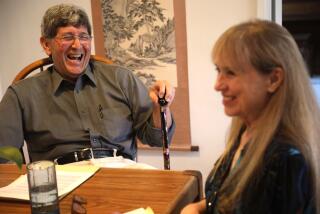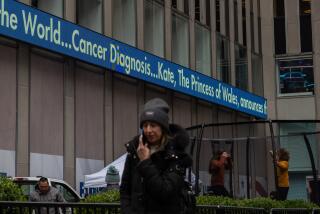Teen With Rare Form of Cancer Also Has Rare Attitude
By any yardstick, the odds look pretty good: If youâre a kid, you only have about a one-in-two-million chance of contracting adrenocortical carcinoma, a particularly rare and virulent form of glandular cancer.
Statistically, that means that out of the entire population of Orange County, only one person should ever get it.
Maria Flores became such a person in 1982, at age 5.
Today, eight years and eight operations later, she continues a solitary fight with adrenocortical carcinoma. Inoperable tumors have spread throughout her body, often leaving her in great pain. They have constricted the blood vessels leading to her legs, causing them to swell painfully and confining her to a wheelchair. She must keep the pain in check with frequent medication, and oxygen is often needed to help her lungs function because of the tumors growing in them.
When she speaks, her voice quavers unevenly.
But, otherwise, it is difficult to tell that Maria Flores is hurting. She smiles as she talks about recently seeing the ocean for the first time, about whales and seals, about her friends at the hospital, about the prize she won in a drawing contest. She is, say the medical personnel who have worked with her at UCI Medical Centerâs cancer center, one of the rarest of patients: a teen-ager in pain who routinely seems more concerned about her family and friends and fellow pediatric cancer patients than about herself.
âSheâs the one who asks every time she comes down to the clinic, âSo whoâs in the hospital? Howâs so-and-so doing?â â said Kristy Zilly, a child life specialist in pediatrics at UCI. âSheâs always keeping up with the other kids who are in the cancer clinic. I donât get that from the other kids.â
In turn, said Zilly, the hospital staff is always happy to see her.
âSheâs everyoneâs pet around here,â Zilly said. âAlmost everyone makes it a point to see her when sheâs here. They say, âOh, Mariaâs here. Letâs go say hi.â â
One of four children of Leobardo and Alba Luz Flores of Placentia, Maria âhas always been very caring and loving,â said her father through a translator. âItâs been very hard for us, but she tries to make everyone feel better. Sheâs been very strong and very thoughtful. Just seeing her trying to keep a positive attitude helps us.â
Such an attitude is all but unheard of among pediatric cancer patients, said Mariaâs oncologist, Dr. Violet Shen.
âThese children, when they get cancer, they really have to go through a lot in their treatment, and it can make them very sick,â Shen said. âThey have to have a lot of needle pokes. Very few of them tolerate it very well. They usually hate it and fight it. And they can get very depressed and refuse to come to the clinic or see the doctor or take their medicine. But Mariaâs very brave. She has bad days sometimes, but she never gets angry or complains. She always smiles, even though she knows the disease is incurable.â
Maria already has beaten very long odds.
Shen said that most people who are stricken with adrenocortical carcinoma die within three to five years. In Mariaâs case, surgeries and chemotherapy had removed or reduced the number of tumors in her body over the last six years, but about eight months ago tumors continued to grow without responding to treatment. And, as the pain became more acute, drugs had to be introduced in an attempt to lessen it.
But, said Zilly, âshe would always try to put on a good face. When weâd be on an outing somewhere, she might have to go to the bathroom to be sick, but sheâd come back and be apologetic, saying she didnât want to spoil the good time for everyone else.â
When the hospital staff learned that Maria had never seen the ocean, they arranged a trip to the Scripps Institution of Oceanography and Sea World in San Diego. During the trip, said Zilly, one of the staff members heard Mariaâs labored breathing as she walked (she was not yet confined to a wheelchair) and offered to carry her.
âShe said, âNo, I always breathe like this in the morning,â â Zilly said. âShe was just so excited to be there. She made a point of bringing seashells home for her family.â
Such forbearance may help ease the ordeals of other children with cancer, Shen said.
âI think that although weâre not able to cure her, scientifically we have learned some (new treatments from her case),â Shen said. âIn the future, we may be able to help more people through what weâve learned. Also, she is so unusual, and she gives so much encouragement to the people who treat her. She shows sheâs able to tolerate the treatment. We know that she can do it, and so we can tell other patients that Maria can do it, that Maria took it very well, and they can, too.â
When Maria herself feels the pain set in, she turns to artwork.
âSometimes when I feel really sick and just lie in bed,â she said, âI try to color. It kind of works.â
Lately, Maria is proudest of a crayon drawing she did that won a drawing contest among the pediatric cancer patients.
âYou had to color a picture of you going to the hospital,â she said. âI drew a nurse putting an IV in my arm. Kristy called me today and said Iâd won a prize.â
In a talking balloon above her smiling self-portrait, Maria printed the words, âIt didnât hurt.â
More to Read
Sign up for Essential California
The most important California stories and recommendations in your inbox every morning.
You may occasionally receive promotional content from the Los Angeles Times.










